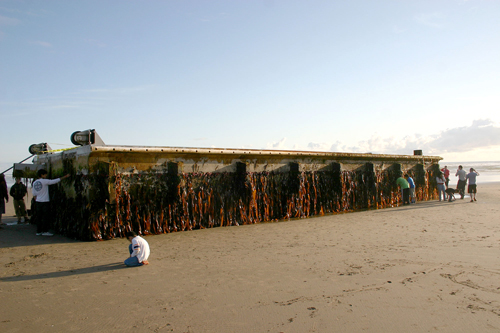How long will waves of tsunami debris hit the West Coast of North America?
And what kind of plants and organisms have hitched a ride thousands of miles across the ocean?
How long will waves of tsunami debris hit the West Coast of North America?
And what kind of plants and organisms have hitched a ride thousands of miles across the ocean?
How long will waves of tsunami debris hit the West Coast of North America?
And what kind of plants and organisms have hitched a ride thousands of miles across the ocean?

Tsunami debris and attached invasive species was the topic of discussion at a workshop held at Portland State’s last week Hoffman Hall.
More than 80 representatives from PSU, federal and state agencies and other jurisdictions were in attendance.
The workshop was an opportunity to link key people from the fields of marine debris and invasive species and develop a response plan.
Answers, however, were in short supply.
The path of the debris is hard to predict, said Brian
Gorman, National Oceanic and Atmospheric Administration spokesman.
“We can expect to see tsunami origin debris coming ashore in the next year or two. It has spread out in the ocean in an area two to three times the size of the U.S., so it is a real challenge,” Gorman said.
Initial estimates by the Japanese government said that 25 million tons of debris were generated by the tsunami. About five million tons of it went into the ocean, and 70 percent sank soon after. The rest of the debris remains floating around in the ocean.
The scope of the problem is unprecedented for the U.S. because of the sheer size of the ocean and the lack of accurate estimates of the amount of debris.
Concerns about nonnative marine life coming over from Japan on debris were sparked in June when a dock from Japan came ashore on Oregon’s Agate Beach. The dock carried with it more than 80 different species, some known to be aggressive invaders. There could be hundreds more in the future. After being cleaned off, over two tons of material were removed from the dock.
“It triggered probably one of the biggest threats we have faced from this tsunami debris field,” said Stephen Brandt, with the Oregon Sea Grant, during his presentation.
James Carlton, professor of marine science at Williams College, said it is wrong to imply that just because a species is not identified as an aggressive invader that it is safe or will not affect a foreign ecosystem.
Anything from Japan could pose a risk to the ecosystem here, Carlton said. “It is not xenophobia; it is reality.”
There is no way to predict the probability of invasive species establishing themselves in North American waters, but as long as debris is coming over and the window of opportunity is open, there is a possibility for invasion, Carlton said.
“The ability for invasive species to establish and survive hangs on so many variables it is absolutely staggering,” he said.
During his presentation, Carlton said it is surprising that anything survived on that dock, as conditions in the open ocean are unforgiving.
“We do not know how they survived,” he said. “Could be that the dock floated along coastlines a lot, where the environment is much more amenable. Or, the dock had an unusually quick trip.”
A nonnative entity could bring over something alien that the native species have no ability to defend against, Carlton said.
Invasive foreign species could have a negative impact on economic and societal resources, as well as introduce human diseases and other toxic elements—not to mention the impact they may have on the environment.
As a course of action in response to Japanese marine debris, Carlton advocated for what he described as a shoot-first-and-ask-questions-later policy, where scientists would be deployed to gather samples and then dispose of the debris immediately.
“We have a long history of working on invasive species here at PSU,” said Mark Sytsma, associate vice president for research. “It is a very important research field at PSU, and we are very established in this area.”
The landing of the dock was a surprise, and the response was ad hoc, Sytsma said. He hopes that the workshop will produce a plan for a quicker, more effective and more organized response, and to get everyone together.
It will be a few weeks before any documents or response plans will be finalized from the workshop. Any plan developed would be entirely voluntary, practicable, adaptive and based in science.
Caren Braby, with the Oregon Department of Fish and Wildlife, looked on the bright side.
“This is a human tragedy, and we are very fortunate we are dealing primarily with trash.”